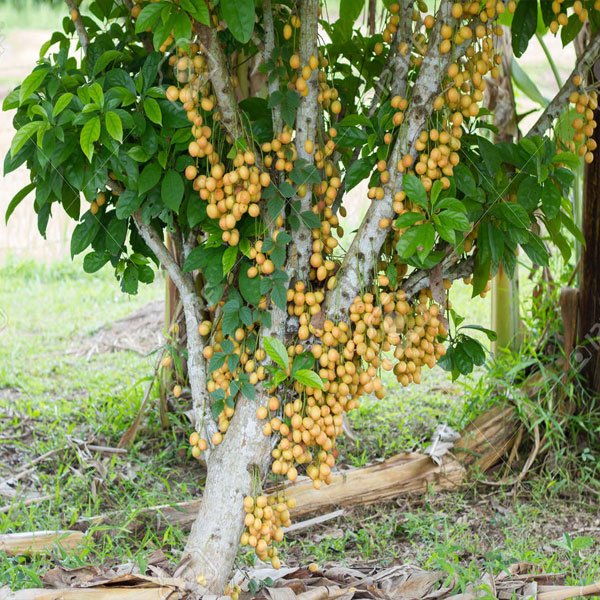Love it? Add to your wishlist
Your favorites, all in one place. Shop quickly and easily with the wishlist feature!
[message]
[title]
[message]



Veliyath Gardens
Couldn't load pickup availability
Botanical Name: Baccaurea ramiflora
Common Names: Burmese Grape, Latka, Leteku, Kataphal
The Burmese Grape, scientifically known as Baccaurea ramiflora, is a semi-evergreen tropical fruit tree native to the lush forests of South and Southeast Asia. It belongs to the Phyllanthaceae family and is admired not just for its vibrant appearance but for the nutrient-rich, medicinally valuable fruit it bears.
Found in the wild groves of countries like India (Northeast and Eastern parts), Bangladesh, Thailand, and Myanmar, this tree thrives in moist, warm climates and grows gracefully, reaching heights up to 25 meters with a broad crown of dense foliage.
Tree height: Can grow up to 20–25 meters tall, especially in favorable conditions.
Branching style: Bears fruits directly from older branches and trunk in a fascinating growth pattern called cauliflory.
Leaves: Glossy, leathery, deep green with a slightly wavy margin.
Flowers: Tiny, pale green to yellowish-white blossoms bloom directly on the branches before fruiting.
This unique cauliflorous fruiting gives the plant a dramatic appearance when loaded with ripe yellow fruit clusters, often covering the tree's main trunk.
The fruits are round to oblong, usually golden-yellow to pale orange when ripe.
Inside, the pulp is soft, juicy, and translucent-white, enclosing 3–4 small seeds.
The taste is a pleasant mix of sweet and mildly sour, with a gentle floral undertone.
Unripe fruits have a slightly acidic bite, while fully ripe ones are lusciously sweet and refreshing.
Many describe the taste as a cross between a longan and a grape, with a smooth texture and a faint tang that balances the sweetness.
India (Assamese): Leteku
Bangladesh: Latka
Nepal: Kataphal
Thailand: Mafai
Myanmar: Tha-zin-thee
These names vary across regions, reflecting its widespread usage in traditional diets and folk medicine.
Burmese Grape is cherished for more than its taste. The fruit, leaves, and even bark have been used in ethnomedicinal practices for generations.
Boosts digestion and relieves constipation due to its fiber-rich pulp
Acts as a cooling agent during hot seasons and reduces body heat
Known for anti-inflammatory and antioxidant properties
Helps in managing blood pressure and supports heart health
The leaf extracts are used in traditional preparations to treat skin infections
Also used as a mild sedative and for calming the nervous system in folk remedies
Its gentle detoxifying effects and hydrating nature make it ideal for summer consumption.
Vitamin C: Enhances immunity and supports collagen production
B-complex vitamins: Promotes metabolic activity
Iron and potassium: Support blood health and regulate heartbeat
Dietary fiber: Improves digestion and maintains gut balance
Contains flavonoids and phenolic compounds that fight oxidative stress
With its low-calorie profile and high hydration value, Burmese Grape is a naturally balanced fruit for daily health.
Consumed fresh as a seasonal fruit
Added to fruit salads, chutneys, and sweet pickles
Often blended into refreshing summer drinks in Northeast India and Myanmar
In some cultures, it's lightly crushed and added to fermented beverages or served with spicy salt mixtures
Its balanced sweet-sour note makes it a versatile fruit — a delightful addition to traditional as well as modern kitchens.
Climate: Prefers tropical or sub-tropical regions with adequate rainfall
Soil: Well-drained, loamy soils rich in organic content
Sunlight: Partial to full sun exposure is ideal
Irrigation: Needs consistent watering in the initial stages; later, it adapts well to natural conditions
Growth timeline: Begins fruiting around 5 years after planting
Pruning and care: Occasional pruning enhances fruiting and overall plant structure
Moderate in maintenance, this plant responds beautifully to organic care and thrives well with natural mulch and compost.
The fruits are best enjoyed fresh but can also be:
Sun-dried for storage
Preserved in brine or sugar syrup
Made into tangy preserves or jam
Used in traditional fermented pickles in Northeastern tribal communities
In many regions, Burmese Grape trees are planted as boundary trees or near homes, both for their fruit and as a sign of prosperity and good health. The fruit is shared among neighbors during seasonal festivals and often given to guests as a gesture of warmth and welcome.
Eat it raw as a hydrating snack during hot days
Blend it into a mildly spiced fruit chutney to pair with rice
Add it to salads for a tangy twist
Soak dried slices in warm water for a refreshing infusion
Introduce it to children as a fun, bite-sized fruit rich in nutrients
Its soft pulp and cooling nature make it suitable for all ages — from toddlers to the elderly.
If you’re looking for a unique fruit tree that’s not just beautiful to look at but also deeply rooted in health traditions and cultural warmth, the Burmese Grape is a remarkable choice. It’s a tree of patience, promise, and plenty — waiting to be nurtured and celebrated.
At Veliyath Gardens, we provide carefully nurtured Baccaurea ramiflora plants, ready to bring this golden forest fruit to your home garden. With every season, as the tree matures, it offers a graceful reminder of nature’s timeless bounty.
Climate: Prefers tropical or sub-tropical regions with adequate rainfall
Soil: Well-drained, loamy soils rich in organic content
Sunlight: Partial to full sun exposure is ideal
Irrigation: Needs consistent watering in the initial stages; later, it adapts well to natural conditions
Boosts digestion and relieves constipation due to its fiber-rich pulp
Acts as a cooling agent during hot seasons and reduces body heat
Known for anti-inflammatory and antioxidant properties
Helps in managing blood pressure and supports heart health
Vitamin C: Enhances immunity and supports collagen production
B-complex vitamins: Promotes metabolic activity
Iron and potassium: Support blood health and regulate heartbeat
Dietary fiber: Improves digestion and maintains gut balance




